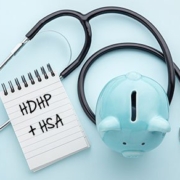Families First Coronavirus Response Act: What Employers Need to Know
- Learn the primary focus of the Families First Coronavirus Response Act.
- Find out what changes have been made to the Emergency Paid Sick Leave Act.
- Learn more about the Paid Sick Time Benefit and how the new rules apply to the timing and time limits of benefits.
- Discover how the Family Medical Leave Act has expanded under the Families First Coronavirus Response Act.
- Learn the procedure for claiming the Social Security Payroll Tax Credit.
- Find out what to do if you need an accelerated payment of the Social Security Payroll Tax Credit.
- Learn more about small business exemptions of the Act.
The Families First Coronavirus Response Act Responds to an Unprecedented Time
The rapid spread of the COVID-19 virus has begun to initiate an economic downturn. It has also spurred a series of rapid responses on the part of the government. There have been so many proposals floated regarding employee policies during this time that employers are understandably confused. There was an initial belief that the crisis would require businesses to make permanent reductions in their work force to survive. However, the final version of the Families First Coronavirus Response Act may make these types of drastic actions unnecessary.
President Trump signed the new law on March 19th, and it will take effect on April 2nd. The economic stimulus measures and allowances that it makes will extend through December 31st, 2020. Make no mistake–this Act is comprehensive. It makes significant changes to previously existing rules regarding both the Family Medical Leave Act (FMLA) and Emergency Paid Sick Leave, as well as in other areas.
The focus of the changes contained in the new law is on companies with fewer than 500 employees. There is already discussion of exemptions for smaller businesses employing fewer than 50 people. The viability of such businesses could be threatened by such measures. Also, the measures covered in the Families First Coronavirus Response Act are not pertinent to companies that employ 500+ employees. Action will likely follow with regard to companies of this size.
Emergency Paid Sick Leave Act
If your company employs fewer than 500 employees, the revised Emergency Paid Sick Leave Act makes them eligible for paid sick leave. This applies regardless of how long they have been employed by you.
If an employee of a company that employs fewer than 500 employees is unable to work in person or to telecommute for any of the following reasons, they qualify for paid sick leave:
- If they are subject to federal, state, or local isolation or quarantine order related to COVID-19.
- If a health care provider advises them that they should self-quarantine as a result of concerns related to COVID-19. *Note: Self-quarantining without advice does not qualify.
- If the employee is seeking medical diagnosis as a result of having symptoms of COVID-19.
- If the employee is caring for someone (not necessarily a family member) who is subject to a federal, state, or local isolation or quarantine due to COVID-19; or who has been advised to self-quarantine by a health care provider as a result of COVID-19.
- If the employee’s child’s school or care facility has been closed or is unavailable as a result of COVID-19 and the employee needs to care for the child.
The Families First Coronavirus Response Act also includes a provision that an employee qualifies if the employee is experiencing any other substantially similar condition specified by the Secretary of Health and Human Services in consultation with the Secretary of the Treasury and the Secretary of Labor.
Defining the Paid Sick Time Benefit
The exact definition of what paid sick time comprises is based upon the number of hours an individual employee works. For those who are full-time employees, paid sick leave is calculated to be 80 hours. Those who work part-time will be entitled to the same number of hours of paid sick leave they would normally work during a two-week period. If someone works a significantly different number of hours each week, the Families First Coronavirus Response Act has a plan. It provides a calculation method in this case to protect these workers.
Referencing the numbered reasons listed above, employees who need paid sick leave based on 1, 2 and 3 will be paid their sick leave benefit. The benefit will be paid at the same rate that they are normally paid. There is a maximum payment of $511 per day and a total of $5,110. Those who need paid sick leave based on the above-referenced reasons numbered 4 and 5 will also be paid their sick leave. Those hours will be paid at a rate equal to two-thirds of their normal pay. The maximum pay will be $200 per day and a total of $2,000.
Timing of the Benefits
The Act makes the emergency paid sick time available as of April 2nd. It specifically prohibits employers from requiring employees to use other accrued paid leave before using the emergency leave. Any existing paid sick leave or paid time off is separate and apart from the leave provided by the Act. This leave remains with the employee. Additionally, though employers may require reasonable notice of using the emergency paid sick leave, this notice is not required until after the first workday (or part thereof) that is used. The employer is not permitted to make employees provide advance notice before the first day that they take paid sick leave under the emergency measures.
These new measures will be explained in a uniform notice. The Secretary of Labor is required to create and provide this notice no later than March 25th. Employers are required to post this notice in a way that all employees are able to see it.
The paid sick leave covered by the Families First Coronavirus Response Act does not carry over into 2021. Similarly, once the qualifying need has passed and the employee returns to work, the paid sick time benefit ceases. Further clarification to help employers calculate leave benefits is forthcoming. There is a requirement for guidelines to be available from the Secretary of Labor no later than April 2nd. We do know employers will be able to apply for reimbursement of these emergency paid sick leave wages through Social Security tax credits.

Emergency Expansion of Family Medical Leave Act through the Families First Coronavirus Response Act
COVID-19 has created countless disruptions in American life. One of the most significant has been the closure of schools and care facilities for children. Employees who have young children needing supervision and care have been torn between parental responsibilities and the need to support their families. In response, the Families First Coronavirus Response Act includes the Emergency Family and Medical Leave Expansion Act (FMLA Expansion Act). It will enable eligible employees to access a federal source of paid leave.
In its original form, the Family and Medical Leave Act’s reach has been limited. Before, it applied to those who work for employers who employ 50 or more people. Amongst that population, it is only accessible to those who have been with their employer for at least a year and have worked at least 1,250 hours in the previous 12 months. For those individuals, the Act provided unpaid leave under highly specific circumstances. These circumstances include their own diagnosis with a serious health condition, to care for a newborn infant or adopted or foster child, or to care for a family member with a serious health condition.
The new Emergency Act expands those rules. It changes the employer threshold to all companies that employ fewer than 500 employees. It also expands those covered to include all workers who have worked for these employers for a minimum of thirty days. As is true of the paid sick leave act, the Secretary of Labor will be able to take action to exempt organizations with fewer than 50 employees if their business’ viability is threatened by making this leave available. Additionally, certain health care providers and emergency responders may also be exempted.
Regarding Companies of 500 or More Employees
Under the Expanded FMLA Leave Act, employees of companies that employ fewer than 500 employees are able to take up to 12 weeks of leave. This applies if they can’t work (in person or via telework) because of their care responsibilities for a child or children under 18 years of age whose school or care facility has been shuttered as a result of COVID-19. The twelve-week period will provide compensation after the first ten unpaid days. Employees can use accrued paid sick or vacation time to provide payment for those ten days.
The compensation will be calculated at two thirds of the employee’s normal wages for the number of hours that they were regularly scheduled to work. This compensation maxes out at $200 per day and a total of $10,000. The program will become available on April 2nd. Though the Act specifies that if the need for leave is anticipated, the employee should provide their employer with “such notice of leave as is practicable,” advance notice is not required.
Regarding Companies of 25 or More Employees
Employees who work for companies that employ 25 or more employees and who fear that they will lose their job or position as a result of taking advantage of this emergency FMLA act are entitled to return to the same or equivalent position once their leave is finished. Employees of smaller companies (with fewer than 25 employees) are also covered by this rule. If the position no longer exists as a result of changes in economic or operating conditions related to/resulting from COVID-19 and the public health emergency, an exception is made. Even under these circumstances, the emergency Family Medical Leave Act requires employers to do their best to put the employee into an equivalent position. If that fails, an equivalent position should be offered to the employee should one become available for at least one year.
What This Means
We are hearing this far too often, but we are in uncharted waters when it comes to COVID-19. Though times are uncertain, employers and employees should know that the Families First Coronavirus Response Act is a strong measure. It recognizes the real-world needs of both sides.
States may provide their own additional benefits at some point, but what the federal government has done means that those with full-time jobs working for companies with less than 500 employees can have confidence that they will be paid both for up to 12 weeks of FMLA if their child’s school or care facility closes down as a result of COVID-19, with all but the first ten days paid at their full rate (but no more than $200 per day and $10,000 in total). It all adds up to a maximum of no more than $12,000. This represents a significant cushion as compared to what had previously been available.
Similarly, full-time employees who can’t work as a result of the first three reasons that meet the Paid Sick Leave Act criteria can receive 80 hours of Federal Paid Sick Leave from their employer at either their full regular rate or a maximum of $511 per day and $5,110 in total. Employees are also permitted to use any paid sick leave, paid time off or paid vacation days they have accrued. They are not, however, required to do so before taking advantage of the benefits of the federal emergency act.
The Emergency FMLA provisions will not be triggered by quarantine, although there may be traditional, unpaid FMLA leave rights available, as well as unemployment insurance.
Social Security Payroll Tax Credit and the Families First Coronavirus Response Act
Employers who provide Emergency Paid Sick Leave benefits and Emergency Child Care Leave benefits will be given refundable tax credits against their Social Security taxes. This will refund them fully for qualified sick leave and childcare leave wages under the Act. A similar credit is available for self-employed individuals against their self-employment tax.
Procedure for Claiming this Credit
Under additional guidance that will be later released, eligible employers who pay qualifying sick or childcare leave will be able to retain an amount of the payroll taxes equal to the amount of qualifying sick and childcare leave that they paid, rather than deposit them with the IRS.
The payroll taxes that are available for retention include:
- Withheld federal income taxes,
- Employee share of Social Security and Medicare taxes, and
- Employer share of Social Security and Medicare taxes with respect to all employees.
What if I need an accelerated payment?
What if you do not have sufficient payroll taxes to cover the cost of qualified sick and childcare leave paid? Employers will be able file a request for an accelerated payment from the IRS. The IRS expects to process these requests in two weeks or less. The details of this new, expedited procedure are forthcoming.
Example – If an eligible employer paid $5,000 in sick leave and is otherwise required to deposit $8,000 in payroll taxes, including taxes withheld from all its employees, the employer could use up to $5,000 of the $8,000 of taxes it was going to deposit for making qualified leave payments. The employer would only be required under the law to deposit the remaining $3,000 on its next regular deposit date.
Example – If an eligible employer paid $10,000 in sick leave and was required to deposit $8,000 in taxes, the employer could use the entire $8,000 of taxes in order to make qualified leave payments and file a request for an accelerated credit for the remaining $2,000.
How do these credits apply to self-employed individuals?
Equivalent childcare leave and sick leave credit amounts are available to self-employed individuals under similar circumstances. These credits will be claimed on their income tax return and will reduce estimated tax payments.
What about small business exemptions?
Small businesses with fewer than 50 employees will be eligible for an exemption from the leave requirements relating to school closings or childcare unavailability where the requirements would jeopardize the ability of the business to continue. The exemption will be available on the basis of simple and clear criteria that make it available in circumstances involving jeopardy to the viability of an employer’s business as a going concern. The Labor Department will provide emergency guidance and rulemaking to clearly articulate this standard.
Non-Enforcement Period
The Labor Department will be issuing a temporary non-enforcement policy. This policy will provide a period of time for employers to come into compliance with the Act. Under this policy, Labor will not bring an enforcement action against any employer for violations of the Act so long as the employer has acted reasonably and in good faith to comply with the Act. Labor will instead focus on compliance assistance during the 30-day period.
There is so much important information in this Act, and we know you may have questions. Fiducial is here to guide you through this difficult time. For more small business COVID-19 resources, visit Fiducial’s Coronavirus Update Center to find information on SBA loans, tax updates, the Paycheck Protection Program, paid sick and family leave, and more. If you need help, call Fiducial at 1-866-FIDUCIAL or make an appointment at one of our office locations. Ready to book an appointment now? Click here. Know someone who might need our services? We love referrals!









